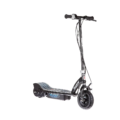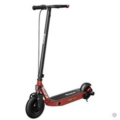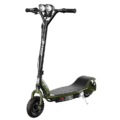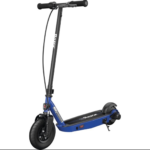- Home
- Scooters
- Electric Scooters
- Razor E200 HD
Razor E200 HD
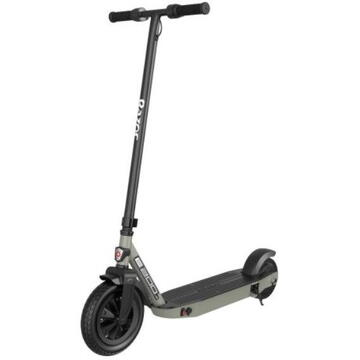



- Battery Range: 12 mi (19 km)
- Top Speed: 12 mph (19 km/h)
- Motor Power: 250 W nominal
- Weight Capacity: 154 lb (70 kg)
- Charging Time: ~6–7 h
- Scooter Weight: 35.0 lb (15.9 kg)
PROS
- Quiet hub motor for low upkeep
- Measured, beginner-friendly throttle
- Solid tires resist punctures
- Bright lighting and reflectors
- Simple fold and storage
CONS
- Firm ride on brick/pavers
- Range dips in cold & hills
- No suspension hardware
- Not for steep grades

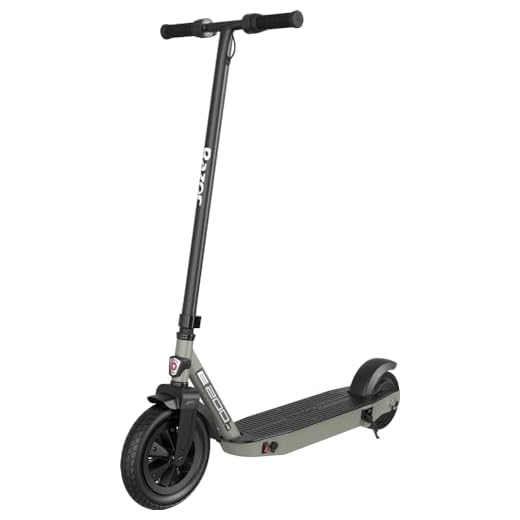
Table of contents
- What Is the Razor E200 HD?
- How the Razor E200 HD Works
- Key Specifications
- Design & Build Quality
- Performance Fundamentals
- Battery, Range & Efficiency
- Ride Quality & Comfort
- Braking & Safety Features
- Portability & Daily Usability
- Maintenance & Care
- Weather & Seasonal Considerations
- Razor E200 HD vs Alternatives
- Who the Razor E200 HD Is (and Isn’t) For
- FAQs
- Glossary
- Final Thoughts
The Razor E200 HD is a compact, entry-level electric scooter aimed at neighborhood rides, school-campus hops, and short errands. It favors simple controls, predictable handling, and easy care over raw speed. If you want a no-drama platform for young riders or new adults learning the ropes, the Razor E200 HD delivers a steady, confidence-building experience without extra complexity.
What Is the Razor E200 HD?
The Razor E200 HD is a youth-to-entry scooter that prioritizes stability and simplicity. Instead of chasing top-end numbers, its design focuses on approachable acceleration, straightforward braking, and a sturdy frame. Its ride posture is upright and relaxed. As a result, it works well for short commutes, campus shuttles, and weekend spins around local paths.
Unlike bigger commuter or performance machines, this model leans into reliability and predictable manners. The deck height suits most teens and many smaller adults, while the cockpit is intentionally uncluttered. It is built to be friendly: easy to step on, easy to start, and easy to stop.
How the Razor E200 HD Works
At its core, the Razor E200 HD pairs a wheel-integrated electric motor with a basic speed controller and a sealed battery pack. Here’s how each piece contributes:
- Motor
The hub motor is housed in a wheel, which means there are no external chains or belts to maintain. Think of it like the wheel itself is “powered.” You press the throttle, current flows, magnets push the wheel around, and off you go. Because the motor is integrated, engagement feels smooth and linear rather than jerky. - Controller
The controller is the electronic “traffic cop.” It decides how much power the motor gets based on throttle position, battery status, and built-in protections. If you floor the throttle, the controller meters current so the scooter pulls away without sudden surges. - Battery
The sealed pack sits in the chassis. Capacity is tuned for short-range rides, school-run loops, or a couple of neighborhood errands. The battery feeds the controller, which feeds the motor. When charge gets low, the controller tapers performance to keep the system within healthy limits. - Throttle
The twist-style throttle on the handlebar is your primary control. Rotating it is like opening a faucet: a bit of twist gives a trickle of power for gentle starts; more twist increases flow for brisker pulls. Because the power band is mild, beginners can modulate speed without twitchiness. - Brakes
The system uses a simple mechanical brake (and, depending on variant, a fender-actuated rear brake). Mechanical brakes are direct and easy to understand: you pull a lever or press the fender, friction slows the wheel. The lever feel is light and predictable, which helps new riders learn smooth stops.
Overall, the machine is set up to behave like a calm bicycle with a motor. Start gently, build speed steadily, and stop with a clean, firm squeeze. That’s the tone of the E200 HD.
Key Specifications
Exact components may vary slightly by production year or region. Where features differ by batch, we note that for clarity.
General
| Item | Details |
|---|---|
| Product class | Youth-to-entry electric scooter |
| Intended use | Neighborhood rides, campus trips, short errands |
| Rider posture | Upright, relaxed stance |
| Water exposure | No formal water rating; avoid heavy rain and puddles |
Performance & Power
| Item | Details |
|---|---|
| Drive | Wheel-integrated hub motor (direct drive) |
| Throttle response | Smooth, beginner-friendly ramp |
| Hill behavior | Handles gentle neighborhood grades; momentum and rider technique matter on steeper sections |
| Top-end character | Tuned for control rather than high speed |
Battery, Charging & Electrical
| Item | Details |
|---|---|
| Battery pack | Sealed, maintenance-light pack sized for short trips |
| Charging | Standard wall charger; plan ahead charging rather than “splash and dash” |
| Battery protection | Controller-based safeguards for current and low-voltage behavior |
Build & Dimensions (include folded dimensions)
| Item | Details |
|---|---|
| Frame | Steel chassis with a sturdy, simple layout |
| Deck | Full-foot deck with grippy surface |
| Stem | Fixed stem for durability and predictable steering |
| Folded dimensions | N/A (non-folding design) |
Safety & Control
| Item | Details |
|---|---|
| Primary brake | Mechanical system with friendly lever feel |
| Secondary action | Fender-actuated rear slowdown on some variants |
| Visibility | Basic reflectivity; add dedicated lights if riding at dusk |
| Speed management | Controller moderates power as battery gets low |
Features & Extras (include Cruise Control if relevant)
| Item | Details |
|---|---|
| Kickstand | Included, for upright parking |
| Cruise Control | Not included; manual throttle management keeps things simple |
| Display / App | No complex screens or app dependencies |
Warranty & Compliance
| Item | Details |
|---|---|
| Warranty | Limited manufacturer warranty terms vary by region |
| Local rules | Speed/age/helmet laws differ; always check your area’s requirements |
| Safety gear | Helmet recommended; gloves and visible clothing improve safety |
Design & Build Quality
The Razor E200 HD feels straightforward and solid in hand. The steel frame resists flex during curb cuts and driveway transitions, and the fixed stem gives consistent steering feedback. The deck is long enough to place your dominant foot forward and the other across or behind, and the surface is grippy even when dust gathers. Because the scooter avoids complicated folding joints, it cuts down on hardware that could loosen over time.
The cockpit keeps clutter away from new riders. A twist throttle sits on the right, the brake lever on the left in most configurations, and the handgrips have enough texture for gloveless use. Cable routing is tidy, with minimal rubbing against the headtube. There’s enough bar width for comfortable leverage without feeling oversized for smaller riders.
Fit-and-finish is intentionally utilitarian. Welds look workmanlike, and paint coverage stands up to light scuffs from locker storage and hallway corners. The deck edge is rounded enough that it won’t chew up shoes, and the kickstand is easy to deploy even on grass. In daily handling, the chassis strikes a smart balance: tough enough for regular use, yet not so heavy that younger riders struggle to upright it.
Performance Fundamentals
Because it is tuned for accessibility, the Razor E200 HD focuses on traction and composure rather than sprint numbers. When you roll on the throttle from a stop, the motor builds smoothly. There isn’t a sudden “hit,” which reduces front-end lightness and helps keep steering true. On flat paths, you settle into a steady cruise quickly. The deck height feels natural, so your weight stays centered, which makes steering corrections relaxed and precise.
On mild hills—think neighborhood streets and park approaches—you’ll feel the scooter slow as grade increases. If you carry momentum into the slope and keep your stance compact, it tracks well. However, long, steep climbs will ask more of the system. In those cases, the better tactic is to plan routes that avoid sustained steep grades or to dismount briefly and walk the sharpest bit.
At higher cruise, the chassis remains calm. Because the stem is fixed, you don’t fight latch play or hinge wobble. Inputs stay small: a light push through your toes to initiate a turn, a gentle counter-pressure to straighten up. As surfaces change—from smooth sidewalk to coarser asphalt—you can hear more road texture, but steering stays predictable.
Battery, Range & Efficiency
Real-world range depends on rider weight, temperature, grade, and how often you stop and start. The Razor E200 HD is meant for short trips: a swing to a friend’s house, a library run, or a campus class loop. When you ride steadily on flat ground at moderate speeds, you’ll get the most from the pack. Frequent full-throttle sprints, hill repeats, and cold weather all reduce distance.
Because the pack is sealed and designed for longevity within its class, charging is straightforward. Plug in after rides rather than letting the scooter sit empty. Partial charges are fine for top-ups. If your storage area is cold, let the scooter warm to room temperature before charging so the pack accepts energy comfortably. Conversely, in hot summers, park it in shade and allow the battery to cool before you plug in.
Efficiency improves with smooth inputs. Roll on the throttle gently, maintain a constant pace, and look far ahead to avoid repeated stop-and-go. Stopping distances shrink when you’re not arriving at corners hot, and your battery rewards calm riding with more useful miles.
Charging best practices:
- Store the scooter dry and indoors whenever possible.
- Avoid full discharges; keep the pack within a mid-range state of charge for day-to-day use.
- If you won’t ride for a while, leave the battery partially charged and revisit it periodically.
Ride Quality & Comfort
Ride feel depends heavily on tires and pressure. The Razor E200 HD has been produced with different tire approaches across batches. Some units use air-filled tires that absorb small chatter; others use solid designs that trade compliance for near-zero maintenance. If yours is pneumatic, check pressure regularly. A few PSI low makes the ride muted but can increase rolling drag and pinch risk. A few PSI high sharpens steering but transmits more vibration. Aim for the manufacturer’s recommended range.
There is no dedicated suspension, so the deck communicates surface texture. On smooth paths, the scooter glides quietly. On coarse, pebbly asphalt, you’ll feel a buzz through the soles and grips. You can reduce that sensation by loosening your knees and elbows—become the “suspension.” Keep your weight slightly back over the rear third of the deck when traversing expansion joints; that stance keeps the front light and helps it skim over edges.
Stem flex is minimal thanks to the fixed design. During quick left-right maneuvers, the bars track in line with the wheel without a laggy rebound, so slaloms feel natural. Ergonomics are friendly to smaller hands: the grips are narrow enough to hold without strain, and the brake lever pull is short and light. Taller riders can still settle in, though they may prefer a slight staggered foot placement to lengthen the cockpit.
Braking & Safety Features
Braking on the Razor E200 HD is intentionally straightforward. A mechanical system translates your lever squeeze or fender press into friction at the wheel. The bite ramps up progressively, so you can scrub five percent of speed or come to a clean stop at a crosswalk. Practice threshold braking in a safe, open area: add lever until you hear the tire beginning to “talk,” then ease slightly. That drill helps you build muscle memory for emergency stops.
Because this scooter targets daytime use, plan for your own visibility if you ride near dusk. Reflective clothing or add-on lights dramatically improve conspicuity. Do a quick walk-around before each ride:
- Spin each wheel to ensure it turns freely.
- Squeeze the brake lever to confirm firm engagement.
- Check that fasteners on the bar clamp and stem are snug.
- Verify the kickstand springs back smartly.
Water awareness matters. Without a formal IP rating, treat puddles, heavy rain, and flooded gutters as off-limits. Water and electronics are a poor mix; overspray also makes braking surfaces slick. If you do encounter moisture, towel the scooter dry afterward and avoid charging until it is fully dry.
Portability & Daily Usability
The Razor E200 HD doesn’t fold, which actually simplifies daily living. There is no hinge to rattle or latch to wear. You store it like a sturdy bike: lean it on the kickstand in a garage, slide it into a hallway corner, or nose it under a desk if space allows. Carrying it for long distances isn’t the plan, yet short lifts over a curb, into a trunk, or up a small flight of stairs are manageable for most adults.
For multi-modal days—train plus scooter—think through the handoff points. Where will you stand with the scooter? Is there a designated area on the platform? Practice rolling it in walking mode, fingers on the brake lever, ready to stop the wheel if it spins as you guide it across gaps.
Security starts with habits. Park near people, within your line of sight if possible. Use a lock through the frame if your situation calls for it, and don’t leave it outside in bad weather. Label the scooter with contact information inside the deck or under the grip as a discreet recovery aid.
Maintenance & Care
The beauty of the Razor E200 HD is its low-drama maintenance. There is no chain to lube and no belt to tension. Keep a short checklist and you’ll stay ahead of wear:
Before each ride (30 seconds):
- Tire check: look for cuts, embedded debris, or soft feel if pneumatic.
- Brake check: lever should firm up before the bar.
- Fastener glance: stem clamp, handlebar bolts, wheel hardware.
Weekly (5 minutes):
- Wipe down the deck and bars to clear grit.
- Confirm kickstand spring tension and pivot smoothness.
- Inspect brake pad/shoe/liner contact for even wear; adjust per the manual if travel feels long.
Monthly (10–15 minutes):
- If pneumatic, set tire pressure with an accurate gauge.
- Check cable housing for kinks or fray points near the lever.
- Verify all major bolts meet recommended torque (use a small torque wrench if available).
Battery habits:
- Top up after rides; avoid deep discharge.
- Store indoors at moderate temperature.
- If idle for weeks, cycle the pack: ride briefly, then recharge to a comfortable mid-level.
Because the scooter lacks a firmware/app layer, there are no software update routines to manage—another way this platform keeps things simple.
Weather & Seasonal Considerations
Rain: Without a water rating, wet conditions are risky. If you’re caught by a sprinkle, cut the ride short and head home at reduced speed. Wet braking distances increase, and painted lines become slick. Dry the scooter fully before charging.
Heat: High temperatures reduce battery comfort. Park in shade, and let the pack cool before charging. During heat waves, consider shorter rides with gentler acceleration to limit heat buildup.
Cold: Capacity dips in the cold, so range shrinks. Pre-ride, store the scooter indoors; you’ll start with a warmer pack and better performance. Expect more road buzz in cold weather as tire rubber stiffens. In frost, skip the ride altogether: traction plummets.
Seasonal tune-ups: At summer’s start, refresh tire pressure, recheck braking feel, and clean the deck. Before winter, charge to a moderate level, store indoors, and schedule a light monthly top-up if it will sit.
Razor E200 HD vs Alternatives
Razor E200 HD vs commuter class: Commuter scooters often add folding hinges, taller stems, and longer decks. They stretch range and may climb hills better. However, they also add cost and complexity. If your rides are short and your storage is tight, the E200 HD’s simplicity is a feature, not a bug.
Razor E200 HD vs performance class: Performance machines use bigger motors, larger batteries, dual brakes, and wider bars. They excel at acceleration and stability at speed. Yet they are heavier, more expensive, and can overwhelm newcomers. The E200 HD stays approachable and easy to manage.
Razor E200 HD vs off-road class: Off-road scooters add knobby tires, suspension, and reinforced frames. They handle ruts and roots, but those upgrades increase weight and maintenance. If your reality is sidewalks and smooth paths, the E200 HD is the better fit.
For riders who prefer a seated, cargo-friendly platform with a full-size bicycle-style frame, consider the Razor EcoSmart Metro HD it favors comfort and utility over compact portability.
Where the E200 HD excels:
- New rider training and skill building
- Short-range errands and campus loops
- Low-maintenance ownership and simple storage
Where it may not be ideal:
- Long commutes with steep hills
- Heavy riders seeking high-speed stability
- Night riding without aftermarket lighting
Who the Razor E200 HD Is (and Isn’t) For
Great for:
- Students who want a friendly, dependable campus shuttle
- Parents looking for a controlled, steady scooter for teens
- Casual riders who value predictability over speed
- Households that prioritize low maintenance
Maybe not for:
- Daily commuters needing long range or strong hill climbing
- Riders who expect suspension and high-grip pneumatic tires on rough surfaces
- Anyone planning frequent night rides without upgrading lights
The Razor E200 HD emphasizes confidence. If your rides fit within its calm, short-trip envelope, it’s a comfortable and trustworthy choice.
FAQs
1) How fast does the Razor E200 HD feel on neighborhood paths?
It settles into a controlled cruise suitable for shared spaces. Acceleration is smooth, which makes it easy to manage near pedestrians and driveway crossings.
2) What kind of maintenance does the Razor E200 HD need?
Very little. Keep an eye on tire condition and pressure (if pneumatic), confirm brake feel, and check a few bolts. Wipe it down weekly and store it dry.
3) Can the Razor E200 HD climb hills?
It handles gentle neighborhood grades best. For long or steep climbs, plan alternate routes or carry momentum into the incline. Walking brief steep sections is often faster and kinder to the system.
4) Is the Razor E200 HD suitable for riding in the rain?
It lacks a formal water rating, so avoid heavy rain and standing water. Wet surfaces also increase stopping distance. Dry the scooter completely before charging.
5) What’s the real-world range of the Razor E200 HD?
Range varies with rider weight, temperature, terrain, and riding style. Smooth throttle, flat ground, and mild weather produce the best distance.
6) Do I need special tools to maintain the Razor E200 HD?
No. A basic hex key set, a small adjustable wrench, and a tire gauge (if pneumatic) cover most checks. A compact torque wrench is helpful but optional.
7) Where can I learn more in a “Razor E200 HD overview” format?
Start with your owner’s manual for model-specific details, then build confidence through short practice sessions in a safe, open area.
Glossary
- Amp-hour (Ah): A measure of battery capacity describing how much current the pack can deliver over time.
- Watt-hour (Wh): Battery energy content; Ah multiplied by pack voltage. Useful for comparing range potential.
- Controller: The electronic unit that meters power from the battery to the motor based on throttle input and safety limits.
- Hub Motor: A motor built into the wheel itself; it drives directly without chains or belts.
- Torque: Twisting force from the motor that initiates acceleration and helps on hills.
- Regen (Regenerative Braking): System that feeds energy back to the battery when slowing. Not a primary brake and not present on all models.
- Stem Flex: The amount the handlebar post bends under load. Less flex improves steering precision.
- IP Rating: Ingress Protection grade for dust and water. Without a rating, avoid wet use.
- Mechanical Brake: A friction-based brake using cables and pads or shoes to slow the wheel.
- Throttle: The rider control that requests power; twisting or pressing it increases motor output.
- Kickstand: A small leg that supports the scooter when parked.
- Pneumatic Tire: Air-filled tire that cushions bumps and improves traction.
- Solid Tire: Airless tire that reduces maintenance but transmits more vibration.
- State of Charge (SoC): How full the battery is at a given moment.
- Threshold Braking: Technique of squeezing the brake just below the point of wheel lock for maximum deceleration.
Final Thoughts
The Razor E200 HD is built for calm, controlled riding and low-stress ownership. It brings new riders into micromobility without demanding steep learning curves or heavy upkeep. Because it focuses on safety, steadiness, and simple controls, it shines on short trips where predictability matters most. If that describes your daily needs, this scooter’s straightforward personality is exactly the point.
Specifications
General
| Model The Model specifies the exact version or name of the scooter. It helps identify its unique design, features, and specifications within the manufacturer’s product line. Knowing the model makes it easier to compare options, find compatible accessories, or look up support information. | E200 HD |
| Brand The Brand identifies the manufacturer or company that designs and produces the scooter. A trusted brand is a sign of quality, reliability, and good customer support. Well-known brands often have higher standards for safety, performance, and after-sales service, giving you more confidence in your purchase. | Razor |
| Release Date The Release Date indicates when the scooter model was officially launched on the market. This helps you know how current the design, technology, and features are. A newer release date often means updated components, improved performance, and the latest safety or smart features. | 17 November 2025 |
| Recommended Age Recommended Age indicates the minimum age range that the scooter is designed for, based on safety, size, and ease of use. Following the recommended age helps ensure that riders can handle the scooter’s speed, weight, and controls comfortably and safely. Always check local laws and use protective gear, especially for younger riders. | Recommended 13+ |
Performance & Power
| Motor Power (Wattage) What it means: The motor power, measured in watts (W), shows how strong the scooter’s electric motor is. Why it matters: Higher wattage usually means better acceleration, more torque, and improved performance on hills or rough terrain. For example, a 250W motor is good for flat city roads and light riders, while a 500W or 1000W motor provides more power for faster speeds or climbing steep inclines. | 250 W nominal (hub) |
| Top Speed The Top Speed indicates the maximum speed that the scooter can reach under optimal conditions. It’s usually measured on level ground with a fully charged battery and an average rider weight. A higher top speed allows you to travel longer distances faster, but always ensure you ride within legal speed limits and your personal comfort zone for safety. | 12 mph (19 km/h) |
| Battery Capacity Battery Capacity refers to the total amount of energy the scooter’s battery can store, usually measured in ampere-hours (Ah) or watt-hours (Wh). A higher battery capacity means you can ride longer distances on a single charge, reducing the need for frequent recharging. Keep in mind that actual range can vary depending on rider weight, terrain, speed, and weather conditions. | 24 V 8 Ah |
| Estimated Range per Charge The Estimated Range per Charge indicates the average distance the scooter can travel on a single full battery charge. This range is calculated under optimal conditions, such as flat terrain, moderate speed, and average rider weight. Real-world range may vary depending on riding style, terrain, weather, and load. A longer range means fewer recharges and greater freedom for longer trips. | Up to 12 mi (19 km) |
| Hill Climb Ability Hill Climb Ability describes the maximum incline or slope that the scooter can handle while maintaining stable performance. It’s typically expressed as a percentage or in degrees. A higher hill climb rating means the scooter can tackle steeper hills without losing too much speed or power. Actual climbing performance may vary based on rider weight, battery charge, and terrain conditions. | Gentle to moderate slopes |
| Drive System The Drive System refers to how power from the motor is delivered to the wheels. Electric scooters typically use either a hub motor (directly integrated into the wheel) or a chain/belt drive system. A high-quality drive system ensures smooth acceleration, efficient power transfer, and low maintenance. The choice of drive system affects performance, noise level, and overall ride experience. | Rear hub motor (RWD) |
Charging & Electrical
| Charging Time Charging Time indicates how long it takes to fully recharge the scooter’s battery from empty to 100% using the standard charger provided. Faster charging means less downtime and more time on the road. Actual charging time may vary slightly depending on battery capacity, charger output, and environmental conditions. | Approx. 6–7 hours |
| Battery Type Battery Type refers to the specific technology used in the scooter’s battery, which affects performance, lifespan, weight, and charging time. Most modern electric scooters use high-quality lithium-ion (Li-ion) batteries because they offer a good balance of energy density, durability, and low maintenance. A reliable battery type ensures consistent power delivery and longer riding ranges. | Li-ion with Smart BMS |
| Removable Battery A Removable Battery means the battery pack can be easily detached from the scooter for convenient charging and replacement. This feature allows you to charge the battery separately, swap it with a spare for extended range, or securely store it indoors in extreme weather. Removable batteries add flexibility and make it easier to keep your scooter powered up wherever you are. | No external fast charge |
| Regenerative Braking Regenerative Braking is an energy-saving feature that converts some of the energy normally lost during braking back into battery power. When you slow down or brake, the motor works in reverse to generate electricity, which helps extend the scooter’s range and improves overall efficiency. This system also reduces wear on traditional brake components, leading to lower maintenance over time. | Electronic assist + rear brake |
| Lighting Lighting refers to the built-in front and rear lights that enhance visibility and safety when riding in low-light conditions or at night. Good lighting helps you see the road ahead and ensures that other road users can see you. Many scooters include LED headlights, taillights, and sometimes brake lights or side reflectors for added safety and compliance with local traffic regulations. | Headlight + tail/brake + reflectors |
Build & Dimensions
| Scooter Weight Scooter Weight refers to the total weight of the scooter when fully assembled, including the battery. This affects how easy it is to carry, lift, and store the scooter when not in use. A lighter scooter is more portable and convenient for commuting, especially if you need to carry it upstairs or onto public transport. Keep in mind that a sturdy frame and quality components may add to the weight but also contribute to better durability and ride stability. | 35.0 lb (15.9 kg) |
| Maximum Rider Weight Maximum Rider Weight indicates the highest rider weight that the scooter is designed to safely support while maintaining optimal performance and stability. Staying within this limit helps ensure reliable acceleration, braking, and climbing ability, and it protects the frame, suspension, and motor from excessive strain. Exceeding the recommended limit may reduce performance and increase wear on components. | 154 lb (70 kg) |
| Deck Size Deck Size refers to the dimensions of the scooter’s standing platform. A wider and longer deck provides more foot space, allowing you to stand comfortably and adjust your stance while riding. A well-sized deck improves balance and stability, especially on longer rides or at higher speeds. Compact decks, on the other hand, help keep the scooter lightweight and portable. | Low deck; neutral stance |
| Handlebar Height Handlebar Height refers to the distance from the deck to the handlebars, which affects your riding posture and comfort. An appropriate handlebar height helps you maintain good balance, reduces strain on your back and arms, and makes steering more comfortable. Some scooters have adjustable handlebars to fit riders of different heights, while others have a fixed height for a streamlined design. | Teen-friendly bar height |
| Folding Mechanism The Folding Mechanism describes how easily and securely the scooter can be folded for carrying and storage. A well-designed folding system lets you quickly collapse the scooter into a compact size, making it convenient to transport on public transit, store under a desk, or fit into a car trunk. Look for sturdy latches and safety locks to ensure the scooter stays firmly in place when folded or unfolded. | Quick folding latch |
| Dimensions Folded Dimensions indicate the size of the scooter when it’s fully folded. This measurement shows how much space the scooter will take up when stored or carried, making it easier to check if it will fit in your car trunk, under a desk, or in a closet. Compact folded dimensions are ideal for commuters who need to bring their scooter on public transport or store it in tight spaces. | 43.0 × 17.0 × 18.5 in (folded) |
| Material Material refers to the primary construction materials used for the scooter’s frame and key components. High-quality materials like aircraft-grade aluminum, reinforced steel, or durable composites provide strength, stability, and a lighter overall weight. A sturdy material ensures the scooter can handle daily wear and tear while maintaining safety and performance. | Aluminum/steel mix |
Safety & Control
| Brake Type(s) Brake Type(s) describe the braking systems the scooter uses to help you slow down or stop safely. Common brake types include mechanical brakes (like drum or disc brakes), electronic brakes, and foot brakes. Many scooters combine multiple braking systems for added safety and shorter stopping distances. The type and quality of brakes affect your control, especially when riding at higher speeds or on slopes. | Front electronic + rear foot |
| Suspension Suspension refers to the system that absorbs shocks and vibrations while riding, providing a smoother and more comfortable ride over uneven or rough surfaces. Scooters may have front suspension, rear suspension, or dual suspension for better shock absorption and stability. Good suspension helps reduce rider fatigue and improves control, especially when riding on bumpy roads or off-road paths. | None |
| Tire Type Tire Type refers to the kind of tires the scooter uses, which directly affects ride comfort, traction, and maintenance. Common types include solid (airless) tires, pneumatic (air-filled) tires, or hybrid options. Pneumatic tires offer better shock absorption and a smoother ride on rough surfaces, while solid tires are puncture-proof and require less upkeep. The right tire type helps ensure safe handling and a comfortable ride in different conditions. | Honeycomb solid tires |
| Tire Size Tire Size indicates the diameter and width of the scooter’s tires, which affect ride comfort, stability, and how well the scooter handles different terrains. Larger tires generally offer better shock absorption and a smoother ride over bumps and rough surfaces, while smaller tires keep the scooter lighter and more portable. Choosing the right tire size helps ensure a balance between agility and comfort. | 8–8.5 inch class |
| Kickstand The Kickstand is a built-in stand that allows you to park your scooter upright when it’s not in use. A sturdy kickstand keeps the scooter stable and prevents it from tipping over, protecting it from scratches and damage. It also makes storing and accessing your scooter more convenient, whether you’re at home, work, or on the go. | Side kickstand |
| Water Resistance Rating Water Resistance Rating indicates how well the scooter is protected against water and moisture, usually shown as an IP (Ingress Protection) rating. This rating helps you understand whether the scooter can handle light rain, splashes, or wet roads without damage. While most scooters are not fully waterproof, a good water resistance rating adds peace of mind when riding in changing weather conditions. Always avoid deep puddles or submerging the scooter to protect its electrical components. | IPX4 body |
Features & Extras
| Display/Console The Display (or Console) shows important real-time information about your ride, helping you monitor your scooter’s status at a glance. Typical displays show speed, battery level, distance traveled, and riding mode. Some models also include additional features like Bluetooth connectivity, app integration, or backlighting for better visibility at night. A clear and easy-to-read display enhances safety and convenience on every trip. | LED dashboard |
| Ride Modes Ride Modes refer to the different speed and power settings you can choose to match your riding style or road conditions. Common modes include eco for maximum range and energy efficiency, standard for everyday balance, and sport or turbo for higher speed and stronger acceleration. Switching between ride modes allows you to customize performance, conserve battery, and ride safely in various environments. | Beginner, Standard |
| Smart App Connectivity Smart App Connectivity lets you pair your scooter with a dedicated mobile app via Bluetooth. Using the app, you can monitor real-time ride stats like speed, battery level, and range, adjust settings such as ride modes or cruise control, lock the scooter for added security, and sometimes receive firmware updates. This feature adds convenience and allows you to personalize your riding experience right from your smartphone. | App-free basic operation |
| Anti-Theft System The Anti-Theft System helps protect your scooter from unauthorized use or theft. This feature can include built-in alarms, electronic motor locks, GPS tracking, or remote locking through a mobile app. A good anti-theft system provides peace of mind when parking your scooter in public spaces, adding an extra layer of security to safeguard your investment. | N/A |
| Cruise Control Cruise Control allows you to maintain a steady speed without continuously holding the throttle. This feature makes longer rides more comfortable by reducing hand fatigue and providing a smoother, more relaxed riding experience — especially on flat, open roads or bike lanes. For safety, cruise control can usually be easily activated or deactivated while riding. | No (region-dependent) |
| Accessories Included Accessories Included lists the additional items that come with the scooter to enhance your riding experience and convenience. Common accessories may include a charger, kickstand, bell, lights, phone holder, or carrying strap. These extras add value by making your scooter safer, easier to use, and ready to ride straight out of the box. | Bell, reflectors, charger |
Warranty & Compliance
| Warranty Period The Warranty Period indicates how long the manufacturer guarantees the scooter against defects in materials and workmanship under normal use. A good warranty provides peace of mind, showing the brand’s confidence in its product quality. Always check what parts are covered, such as the frame, battery, and motor, and follow the maintenance guidelines to keep your warranty valid. | 12 months typical |
| Certifications Certifications confirm that the scooter meets specific safety, quality, and environmental standards set by recognized organizations or regulatory bodies. Common certifications may include CE, RoHS, UL, or other local compliance marks, depending on your region. These certifications ensure that the scooter is manufactured to high standards and is safe and legal to use in your country. | Local e-scooter compliance |
Price Comparison




